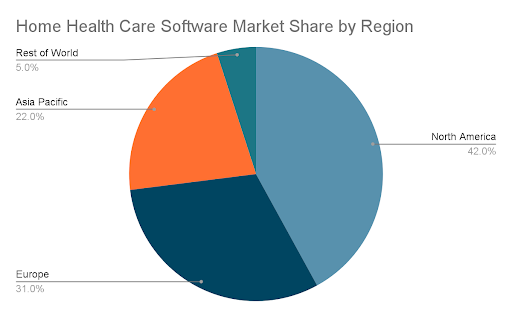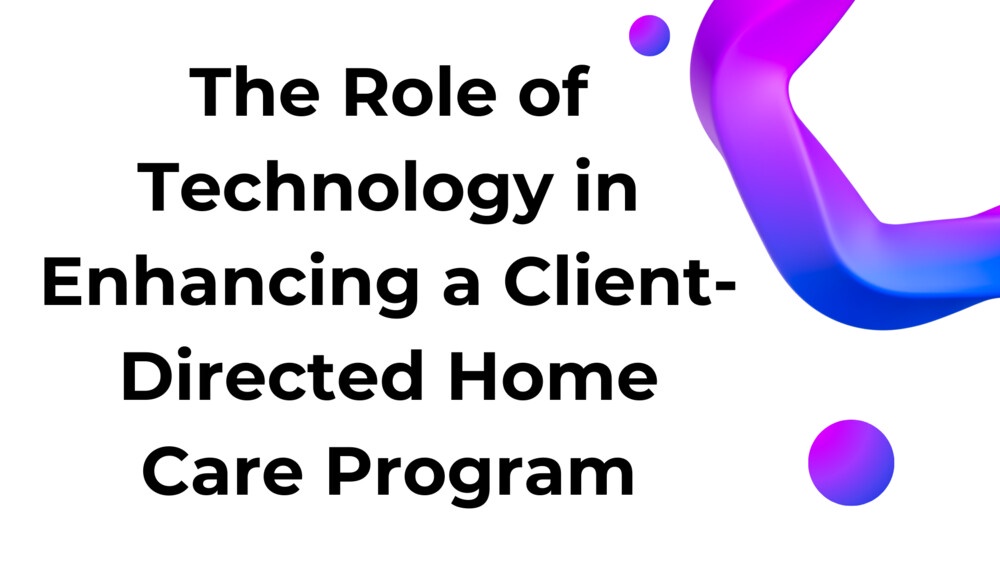The Role of Technology in Enhancing a Client-Directed Home Care Program
Technology has transformed the healthcare landscape, particularly in enhancing the quality of care to patients. This trend is especially noticeable in the home care sector, where innovative tools and technologies are enhancing client-directed care models.
In the dynamic world of home care services, a client-directed home has risen to power as a beacon of hope and empowerment for those who look out for personalized care. The global home healthcare software market was valued at USD 3.2 billion in 2020 and is expected to reach $7 billion by 2026.
Technology-driven home care has evidently become a paradigm shift that aims at addressing the prevailing challenges and also magnifies the overall home care experience for clients.
In this article let’s cover the role of technology in enhancing a client-directed home care program.
The Evolution of Home Care Technology
The home care industry, including senior care in calgary, has faced long-standing challenges like funding limitations, geographic distances between patients and providers, and workforce distribution issues. However, technology in-home care is emerging as a potential solution, enhancing services in significant ways. It has undoubtedly become an innovative power remolding the basis of caregiving.
Advancements in telecommunications, web solutions, and social networking tools hold immense potential to support healthcare delivery and education. One of the futuristic advancements in home care management is the integration of mobile phones.
Integrating electronic communication can facilitate a redesign of home care processes, empowering patients to become active and informed participants in care decisions.
Information and Communication Technology (ICT) in Home Care
ICT in home care refers to the integration of information and communication technologies to deliver, enhance, and manage healthcare services. There are several examples of ICT applications in home care:
Active Monitoring and Management
Remote monitoring devices track health metrics like blood pressure, blood sugar, weight, etc., and send real-time alerts about any concerning changes. This allows healthcare professionals to track the significant changes in the health metrics of the patient and provide timely care.
Telehealth Applications
Platforms like teleconsultations and online second opinions support disease management for chronic conditions. The advancement of telehealth and remote monitoring is considered to be one of the crucial emergencies in-home care technology. The home asthma telemonitoring system, for instance, provides continuous help in asthma self-care.
Web-Based Communities
These virtual platforms enable patient-focused and provider-focused interactions, facilitating information sharing and mutual support. Additionally, it also serves as a supportive hub for the recipients, allowing them to connect with individuals going through similar situations. This helps mitigate the feeling of isolation and fosters a sense of belonging.
Personal Health Records
A Personal Health Record (PHR) is a digital repository of the patient's health-related data.
Digital storage of medical data empowers patients to access their information anytime, anywhere. This plays a vital role in ensuring smooth communication between caregivers, and healthcare providers.
The Impact of Software Development on Home Care
Specialized software and digital platforms designed for home care need to provide tools as well as a sense of community and engagement.
Developments like HHAeXchange enable efficient home care and self-direction program management. This benefits caregivers by simplifying the process of scheduling, recording accurate service hours, and reducing the paperwork and billing process.
Software innovations make it easier for caregivers to access training, authenticate credentials, manage documentation, track outcomes, and coordinate with providers.
Platforms like Talkspace encourage the public to access mental healthcare from home through messaging/video therapy. The anonymity reduces the stigma around seeking help. This technology-driven approach breaks the stereotype of traditional therapy by reducing the burden of having to wait to get personalized mental health care.
Home care software optimizes coordination, provides decision support, reduces errors, and enhances overall quality – ultimately leading to greater patient satisfaction.
Benefits of Specialized Home Care Software
Specialized software solutions are bridging gaps in care through smarter coordination and targeted innovations. Below are some of the benefits of specialized home care software.
- Workflow optimization: It optimizes the workflow of caregivers by streamlining administrative tasks like scheduling, billing, and documentation.
- Care coordination: It promotes effective coordination and smooth communication between the members of the care team as the progress notes, care plans, and all the significant information are readily accessible.
- Reduced errors: The built-in checks and alerts make sure that the client information is accurate.
- Enhanced patient experience: As the streamlined process provides easy access to vital information, it helps the client receive more personalized and enhanced care.
- Improved caregiver training: To ensure caregivers are well equipped, caregivers can make use of training materials provided in the specialized software.
- Secure documentation: Home care software protects patients’ sensitive data from any unauthorized access, ensuring data privacy.
Assistive Technologies and Home Modifications
Beyond software, assistive technologies and structural changes are making home care safer and easier. The right assistive tools and home modifications can make all the difference in maintaining comfort, safety, and dignity. It encompasses a variety of tools and devices that assists individuals with disabilities and senior citizens.
They include devices like lift chairs, grab bars, and sit-to-stand lifts that assist with routine physical tasks like transferring or repositioning.
Technologies like remote health monitoring and GPS tracking provide safety, security and access to care. As this provides seamless transmission of data, it ensures the client is actively taken care of in case of any concerning changes.
Home modifications like ramps widened hallways or doorways, and accessible kitchen/bathroom spaces support mobility and independence.
These interventions reduce the workload and risk of injury for both patients and caregivers. They enhance the quality of life by facilitating basic activities and daily living.
Self-Directed Medicaid Services
Traditional Medicaid home care services offer limited patient control. But self-directed Medicaid services give participants decision-making authority over certain services. Through self-directed Medicaid, the beneficiaries have the power to manage their own care services tailored to their needs and preferences.
The notable benefits of self-directed medicaid services include:
- More flexible scheduling and increased choice of providers
- Ability to hire family members or neighbors as caregivers
- Tailored services based on needs and preferences
- More control over individualized budget
- Provides a sense of autonomy as the individual plays an active role in their care.
Some of the challenges include:
- Complex paperwork and documentation
- Responsibility of being an employer
- Ensuring quality of services
- The requirement and training of caregivers
- Property management and tracking expenses can be challenging
Overall, self-directed models empower patients and improve satisfaction. Despite the challenges, self-directed services provide vital flexibility and autonomy.
The Emergence of Self-Directed Home Care in Different Regions

The value of patient empowerment in-home care is gaining global recognition. This transformative development has revolutionized the way individuals receive and manage healthcare. The healthcare systems and the government has recognized the benefits of self-directed home care and has implemented them in various regions to cater to the personalized needs and preferences of the client.
Ontario, Canada has seen a rise in self-directed care where the government funds recipients to choose their providers. England has piloted an "individual budget" model allowing budget holders to buy services directly. France has also implemented schemes to give funds directly to patients.
This client-centered transition allows recipients to be active consumers and managers of their care. It empowers the clients to own a sense of freedom and independence in choosing their caregivers and determining the type of care they want to receive. Moreover, the impressive approach to this is the client-directed home care invoicing where clients have access to detailed invoices, the corresponding costs, and the outline of the care received.
Around the world, health systems recognize that putting resources and decisions directly into patients’ hands is the way forward.
In-Home Technology for Seniors
In-home technologies tailored for senior citizens empower and provide them with alike actionable insights and care.
Home technology for seniors like wearable devices, voice assistants, medication management tools, etc. allows older adults to tap into advanced care. They are designed to boost the safety, independence, and well-being of elderly people.
- Wearables continuously track health signals and can detect changes or emergencies.
- Voice assistants act as helpers for tasks like controlling appliances, looking up information, or calling caregivers.
- Medication management tools provide reminders and facilitate compliance.
Such technologies provide seniors with immediate access to informed healthcare within the comfort of their homes. They reduce unnecessary hospital visits as the caregivers will remotely monitor them and enable independent living.
Home Care Independence Programs
Home care independence programs are consumer-directed, allowing recipients to manage and direct their services within their own homes. They offer a wide range of services like personal care support, companionship, household support, transportation, and meal preparation.
Some of the key examples of home care independence programs include,
Cash and Counseling program: Gives funds directly to participants to hire caregivers, purchase goods/services and pay relatives or friends.
Veterans Directed Care program: Veterans get flexible budgets to support independence and self-direction of care.
Participant-directed Services: Program enrolling seniors and persons with disabilities in Florida to self-direct care.
Such programs foster independence and put recipients in charge. They allow seniors to age with dignity by choosing services and providers.
The Future Is Client-Directed
Technology has opened exciting possibilities for user-centered, client-directed home care. While there are some complexities and training requirements, the benefits of efficiency, empowerment, and satisfaction are undeniable.
Moving forward, leveraging technology to empower home care recipients will be essential. As innovators and policymakers recognize this shift, we will see self-direction and independence become the norm rather than the exception.
What are your thoughts on the role of technology in enhancing client-directed home care? What challenges do you foresee, and what opportunities excite you the most? Let me know in the comments!


No comments yet